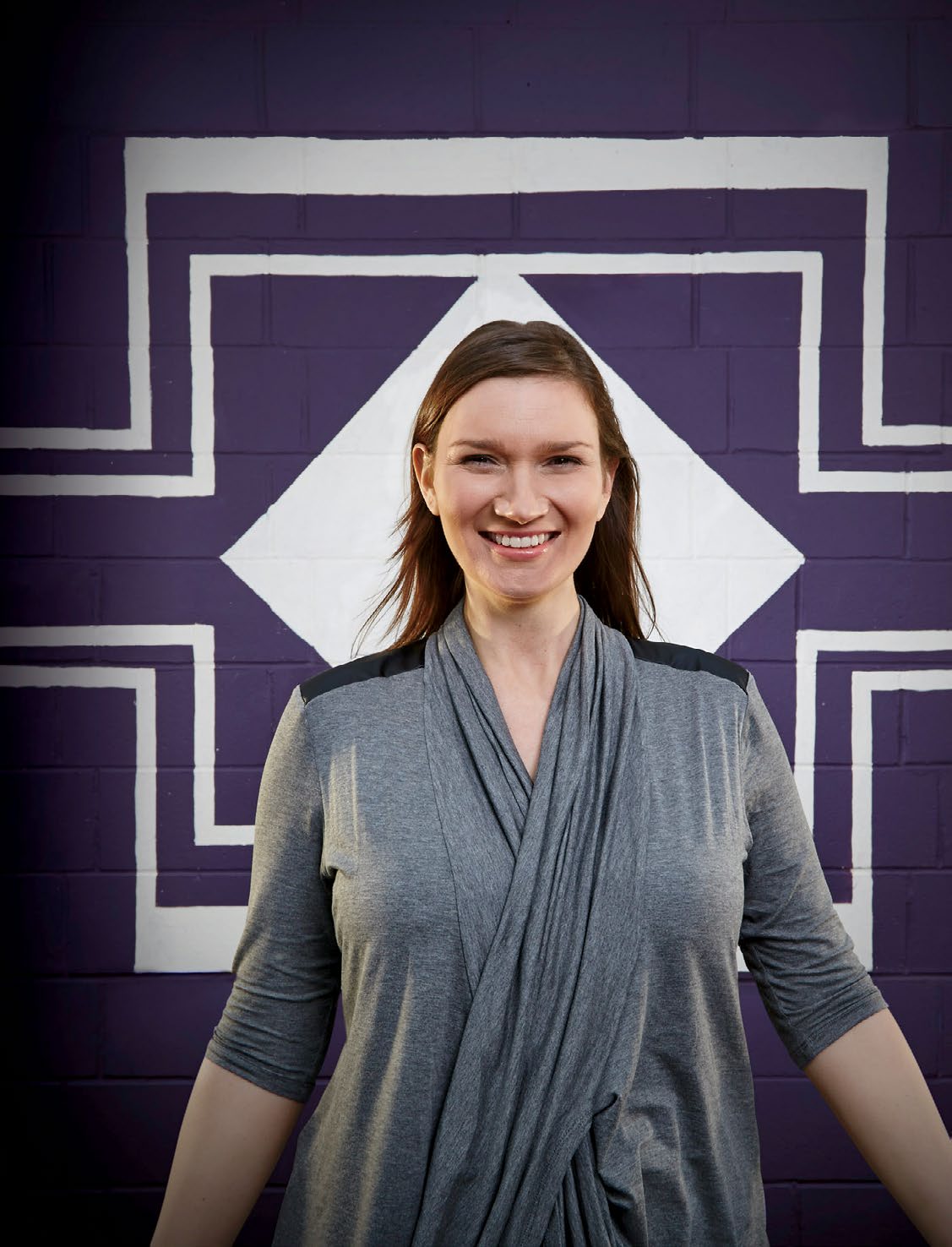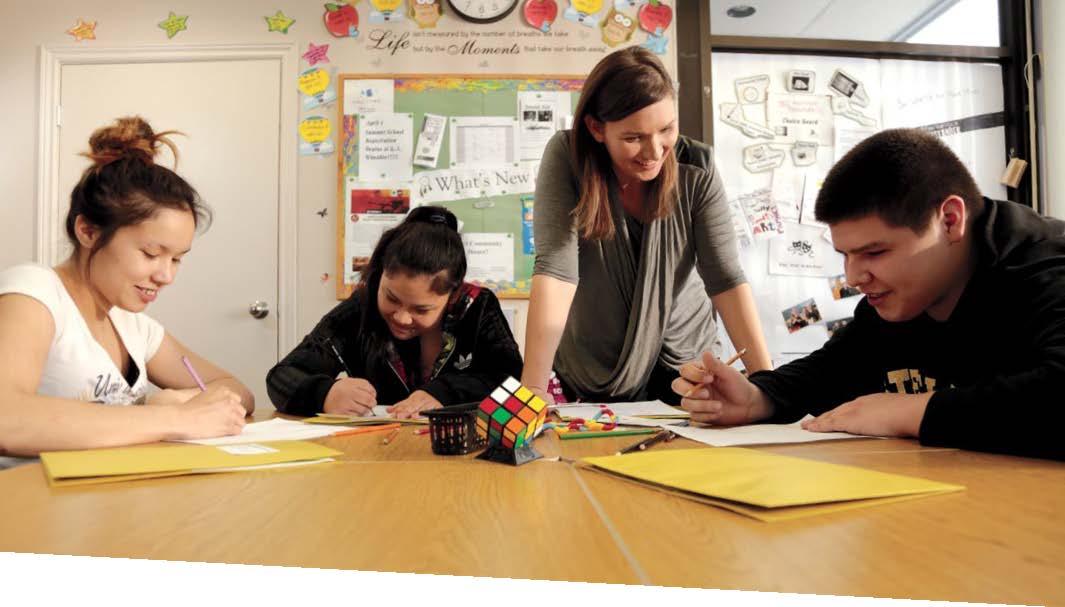Share this page

Samantha Leonard, OCT, teaches at-risk students how to dream big and reach their personal best.
By Trish Snyder
Photos: Liam Sharp
Beginning with this issue, visit professionallyspeaking.oct.ca for video documentaries of our Exemplary Teachers.
“It’s nice to see you.” Samantha Leonard, OCT, means it when she smiles warmly at a teenage girl on an overcast morning at Anishnaabe Skiniiw Centre in Southwold, a Thames Valley DSB alternative classroom. The 17-year-old wearing a hoodie might have quit high school altogether if not for Leonard’s efforts in this one-room school for London-area First Nations students.
Instead of a full day of classes, 14- to 18-year-olds attend two-hour blocks of one-on-one tutoring and self-study. Since Leonard provides a variety of lessons and worksheets (all board approved) for students in every subject, her biggest challenge isn’t teaching multiple grades — it’s getting disenfranchised teenagers in the door and finding ways to make lessons resonate. Most arrive in the program not because of a lack of intelligence, but because it can be hard to keep Shakespeare and algebra at the top of your priorities when your home life is painful, you’re fighting addictions, mental illness or when you’ve been up every two hours feeding a newborn.
With compassion and ingenuity, Leonard is helping frustrated and disillusioned students find success at high school. By re-engaging young people with real-world experience and helping them develop social skills while they tackle credits, Leonard is erasing the stigma of punishment and failure that clings to alternative education and reframing it as a unique, positive place to learn. And, her efforts are paying off. Leonard’s cheerleading has inspired some students to continue learning at adult education programs or college, while giving others the chance to experience something equally important — hope.
“This program is awesome because it helped me succeed at something,” says a former student. It also earned Leonard a Prime Minister’s Award for Teaching Excellence in 2013 for her work at Anishnaabe Skiniiw and two programs that she launched for young parents. “If these students aren’t making it with us, they’re dropping out,” she says. “I don’t want 14-year-olds to be out there on their own.”

Since she earned her teaching degree in 2005, Leonard has spent most of her time in alternative education. In 2010, she launched ReConnect Merrymount in London, Ont., a non-profit crisis centre with a flexible program that gives teenage-parents who’ve dropped out the chance to balance education with their new responsibilities. The goal is to give students the skills they need to be good parents — while they earn credits toward their diplomas — and transition them back to high school so they can graduate.
That year, 22 teen moms and two dads worked independently toward a credit. They earned a second interdisciplinary credit (IDC) for participating as a group in experiential learning activities that covered parenting, fashion, and managing personal and family resources. Leonard ran cooking classes to show students how to make healthy snacks, such as banana bread and smoothies. She walked them through the steps to finding a job, teaching them how to use templates for resumés and cover letters. When students needed baby clothing, Leonard helped them out by making a few calls. It turned out that her board had 30-year-old sewing machines still in storage. So she dusted them off and taught students to sew.
“Samantha could have said, ‘Sorry we don’t have that equipment,’” says Rebecca Howse, OCT, the former principal of Adult, Alternative and Continuing Education for the Thames Valley DSB, who hired Leonard to create the Merrymount program when the centre offered the space. “But she took the initiative to bring in those machines,” Howse says. “She always does whatever she can for her students.” The following year, Leonard established a similar ReConnect program in St. Thomas, Ont.
Leonard landed at Anishnaabe Skiniiw in 2012 — her first full-time contract position — and was put in charge of a modern one-room schoolhouse, supporting students of all abilities in multiple subjects and grade levels. Her first priority was to set a positive tone within the classroom and create a sense of community. She builds trust by giving students the right to pass. Instead of requiring everyone to chime in during class discussions, they can listen without sharing. She set up a kindness tree and decorated it with students’ random acts, everything from holding a door open to sharing a compliment. When someone is absent, she calls to see how they’re doing and welcomes them back without a whiff of accusation. “I’ll say, ‘I was worried about you and I’m glad you’re OK. We missed you.’ I try to make everyone feel like they’re a part of something. If they think that no one cares, it’s too easy for them to hit the snooze button.”
When one of Leonard’s afternoon students stalls on a Grade 10 math problem, the girl tugs out her earbuds and asks for help. For the ones who are reluctant to ask, giving feedback can be an exercise in diplomacy. If she notices someone is stuck, Leonard tries not to single them out. “I’ll ask, ‘Do you mind if I explain this? Or, can I give you an example?’ It’s not punitive or negative. I point out that we’re all here because we need help.”
Instead of handing back assignments criss-crossed with red pen, she reviews the work side by side with each student. She’ll ask, “Did this meet the success criteria? What could we do better?” Most students come up with the fixes themselves — revising a draft or adding colour to a poster — to raise the quality of their work. “There’s a lot of shame and blame in alternative education,” says Howse, “but Samantha gives her students the gift of high expectations so they can hold their heads up and be proud of what they’ve done.”
Constant monitoring keeps everyone moving forward. Leonard assesses most assignments the same day she receives them back and records each student’s progress in their folders. That way they know how many course modules they’ve completed — and how many remain to earn that credit. “If I sit on the marking, they lose the lesson and don’t care anymore.”
With MyBlueprint (myblueprint.ca), a powerful education and career-planning tool, Leonard helps students imagine where their efforts might lead. They use the software to track credits, build a resumé and cover letter, explore requirements for various occupations and identify which postsecondary programs they quality for. She picks up the phone to find students cooperative education opportunities and volunteer positions, so they can collect required volunteer hours and work experience.
Leonard connects Anishnaabe students to their heritage with special guests and field trips — something most alternative education programs just don’t offer [see Leonard’s tips for finding funding on this page]. She’s invited elders to speak about issues that fragment First Nations communities and hosted a local farmer for a wrist-deep lesson in making cornbread. Students attended archery workshops and examined centuries-old First Nations arrowheads at the Museum of Archeology. “These students have their cellphones and headphones so they’re plugged into youth culture, but not all First Nations teens know about their own culture,” says Leonard, who takes cues on First Nations issues from the centre’s educational assistant, Hugh Dickey, a Chippewa elder who has been with the program since its inception.
Success can take many forms in alternative education. In her first year at Anishnaabe Skiniiw, Leonard helped 40 students accumulate 225.5 credits and 90-plus hours of volunteer service, and boosted attendance by more than 9 per cent. But the numbers are only half the story, she says. “I may work with a student to the point where he’s coming in three days a week, attempting work and talking to the counsellor. That may not be worth a credit, but it’s worth something.”
One student had been at the centre for five semesters without accomplishing much. The year Leonard stepped in, the girl acquired 17 credits. When Leonard encouraged her to pursue adult education, she balked — she was terrified of trying something new. “I said, ‘I’m telling you this because I care about you,’” recalls the young teacher, who also arranged for the student to tour a school. “She started to cry — she said no other teacher had ever said that they cared about her.” The girl eventually enrolled in the school and settled in.
Leonard never misses an opportunity to highlight victories like these. She produces year-end videos set to music to show photos of her students enjoying field trips or posing with a certificate of achievement. After a visiting soapstone carver coached students on how to create their own carvings last year, she invited parents and community members to a reception. Marilyn Simpson, OCT, retired vice-principal of Adult, Alternative and Continuing Education, was struck by seeing so many students smiling and proudly carrying around their sculptures. “These are kids who have experienced failure and had stopped caring because they had fallen so far behind. To be able to connect with students and get them to engage again — that’s a huge accomplishment.”
Few experiences have been more powerful for Leonard than watching at-risk students graduate from an alternative education program. When her first class at Merrymount picked up their certificates, she held their babies and listened to their stories of overcoming adversity to be good role models for their children. Some graduates had no parents attending the ceremony, so when they walked across the stage and paused at the handshake, Leonard was there to capture the moment in a photo. “I don’t think of them as just my students,” she says. “I care about them like I do my own children.”
The Exemplary Teachers featured in this department have been recognized with provincial or national teaching awards.
Classroom budgets are lean, so Samantha Leonard uses education grants to afford field trips, special guests and an innovative nutrition program that supplies every student with cooking lessons, recipes and their own slow cooker. Follow these leads to greater funding: